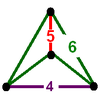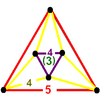Find the complete set of hyperbolic uniform honeycombs.
In hyperbolic geometry, a uniform honeycomb in hyperbolic space is a uniform tessellation of uniform polyhedral cells. In 3-dimensional hyperbolic space there are nine Coxeter group families of compact convex uniform honeycombs, generated as Wythoff constructions, and represented by permutations of rings of the Coxeter diagrams for each family.
 Order-4 dodecahedral honeycomb {5,3,4} |
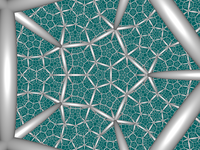 Order-5 dodecahedral honeycomb {5,3,5} |
 Order-5 cubic honeycomb {4,3,5} |
 Icosahedral honeycomb {3,5,3} |
| Poincaré ball model projections | |
|---|---|
YouTube Encyclopedic
-
1/5Views:11 3912 33210 1563 42711 367
-
Hyperbolic honeycombs
-
Spherical sections of the {3,3,7} hyperbolic honeycomb
-
Hyperbolic Tessellation Animation
-
Bridges 2018 talk - Visualizing hyperbolic honeycombs
-
Hyperbolic Catacombs Carousel
Transcription
Hyperbolic uniform honeycomb families
Honeycombs are divided between compact and paracompact forms defined by Coxeter groups, the first category only including finite cells and vertex figures (finite subgroups), and the second includes affine subgroups.
Compact uniform honeycomb families
The nine compact Coxeter groups are listed here with their Coxeter diagrams,[1] in order of the relative volumes of their fundamental simplex domains.[2]
These 9 families generate a total of 76 unique uniform honeycombs. The full list of hyperbolic uniform honeycombs has not been proven and an unknown number of non-Wythoffian forms exist. Two known examples are cited with the {3,5,3} family below. Only two families are related as a mirror-removal halving: [5,31,1] ↔ [5,3,4,1+].
| Indexed | Fundamental simplex volume[2] |
Witt symbol |
Coxeter notation |
Commutator subgroup |
Coxeter diagram |
Honeycombs |
|---|---|---|---|---|---|---|
| H1 | 0.0358850633 | [5,3,4] | [(5,3)+,4,1+] = [5,31,1]+ |
15 forms, 2 regular | ||
| H2 | 0.0390502856 | [3,5,3] | [3,5,3]+ | 9 forms, 1 regular | ||
| H3 | 0.0717701267 | [5,31,1] | [5,31,1]+ | 11 forms (7 overlap with [5,3,4] family, 4 are unique) | ||
| H4 | 0.0857701820 | [(4,3,3,3)] | [(4,3,3,3)]+ | 9 forms | ||
| H5 | 0.0933255395 | [5,3,5] | [5,3,5]+ | 9 forms, 1 regular | ||
| H6 | 0.2052887885 | [(5,3,3,3)] | [(5,3,3,3)]+ | 9 forms | ||
| H7 | 0.2222287320 | [(4,3)[2]] | [(4,3+,4,3+)] | 6 forms | ||
| H8 | 0.3586534401 | [(3,4,3,5)] | [(3,4,3,5)]+ | 9 forms | ||
| H9 | 0.5021308905 | [(5,3)[2]] | [(5,3)[2]]+ | 6 forms |
There are just two radical subgroups with non-simplicial domains that can be generated by removing a set of two or more mirrors separated by all other mirrors by even-order branches. One is [(4,3,4,3*)], represented by Coxeter diagrams ![]()
![]()
![]()
![]() an index 6 subgroup with a trigonal trapezohedron fundamental domain ↔
an index 6 subgroup with a trigonal trapezohedron fundamental domain ↔ ![]()
![]()
![]()
![]()
![]()
![]()
![]() , which can be extended by restoring one mirror as
, which can be extended by restoring one mirror as ![]()
![]()
![]()
![]()
![]() . The other is [4,(3,5)*], index 120 with a dodecahedral fundamental domain.
. The other is [4,(3,5)*], index 120 with a dodecahedral fundamental domain.
Paracompact hyperbolic uniform honeycombs
There are also 23 paracompact Coxeter groups of rank 4 that produce paracompact uniform honeycombs with infinite or unbounded facets or vertex figure, including ideal vertices at infinity.
| Type | Coxeter groups |
|---|---|
| Linear graphs | |
| Tridental graphs | |
| Cyclic graphs | |
| Loop-n-tail graphs |
Other paracompact Coxeter groups exists as Vinberg polytope fundamental domains, including these triangular bipyramid fundamental domains (double tetrahedra) as rank 5 graphs including parallel mirrors. Uniform honeycombs exist as all permutations of rings in these graphs, with the constraint that at least one node must be ringed across infinite order branches.
| Dimension | Rank | Graphs |
|---|---|---|
| H3 | 5 |
|
[3,5,3] family
There are 9 forms, generated by ring permutations of the Coxeter group: [3,5,3] or ![]()
![]()
![]()
![]()
![]()
![]()
![]()
One related non-wythoffian form is constructed from the {3,5,3} vertex figure with 4 (tetrahedrally arranged) vertices removed, creating pentagonal antiprisms and dodecahedra filling in the gaps, called a tetrahedrally diminished dodecahedron.[3] Another is constructed with 2 antipodal vertices removed.[4]
The bitruncated and runcinated forms (5 and 6) contain the faces of two regular skew polyhedrons: {4,10|3} and {10,4|3}.
| # | Honeycomb name Coxeter diagram and Schläfli symbols |
Cell counts/vertex and positions in honeycomb |
Vertex figure | Picture | |||
|---|---|---|---|---|---|---|---|
| 0 |
1 |
2 |
3 | ||||
| 1 | icosahedral (ikhon) t0{3,5,3} |
(12) (3.3.3.3.3) |

|

| |||
| 2 | rectified icosahedral (rih) t1{3,5,3} |
(2) (5.5.5) |
(3) (3.5.3.5) |

|

| ||
| 3 | truncated icosahedral (tih) t0,1{3,5,3} |
(1) (5.5.5) |
(3) (5.6.6) |
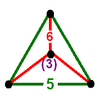
|

| ||
| 4 | cantellated icosahedral (srih) t0,2{3,5,3} |
(1) (3.5.3.5) |
(2) (4.4.3) |
(2) (3.5.4.5) |

|

| |
| 5 | runcinated icosahedral (spiddih) t0,3{3,5,3} |
(1) (3.3.3.3.3) |
(5) (4.4.3) |
(5) (4.4.3) |
(1) (3.3.3.3.3) |
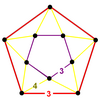
|

|
| 6 | bitruncated icosahedral (dih) t1,2{3,5,3} |
(2) (3.10.10) |
(2) (3.10.10) |
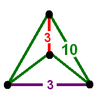
|

| ||
| 7 | cantitruncated icosahedral (grih) t0,1,2{3,5,3} |
(1) (3.10.10) |
(1) (4.4.3) |
(2) (4.6.10) |

|

| |
| 8 | runcitruncated icosahedral (prih) t0,1,3{3,5,3} |
(1) (3.5.4.5) |
(1) (4.4.3) |
(2) (4.4.6) |
(1) (5.6.6) |

|

|
| 9 | omnitruncated icosahedral (gipiddih) t0,1,2,3{3,5,3} |
(1) (4.6.10) |
(1) (4.4.6) |
(1) (4.4.6) |
(1) (4.6.10) |
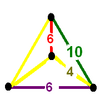
|

|
| # | Honeycomb name Coxeter diagram and Schläfli symbols |
Cell counts/vertex and positions in honeycomb |
Vertex figure | Picture | ||||
|---|---|---|---|---|---|---|---|---|
| 0 |
1 |
2 |
3 |
Alt | ||||
| [77] | partially diminished icosahedral pd{3,5,3}[5] |
(12) (3.3.3.5) |
(4) (5.5.5) |

|

| |||
| [78] | semi-partially diminished icosahedral spd{3,5,3}[4] |
(6) (3.3.3.5) (6) (3.3.3.3.3) |
(2) (5.5.5) |
|||||
| Nonuniform | omnisnub icosahedral (snih) ht0,1,2,3{3,5,3} |
(1) (3.3.3.3.5) |
(1) (3.3.3.3 |
(1) (3.3.3.3) |
(1) (3.3.3.3.5) |
(4) +(3.3.3) |

|
|
[5,3,4] family
There are 15 forms, generated by ring permutations of the Coxeter group: [5,3,4] or ![]()
![]()
![]()
![]()
![]()
![]()
![]() .
.
This family is related to the group [5,31,1] by a half symmetry [5,3,4,1+], or ![]()
![]()
![]()
![]()
![]() ↔
↔ ![]()
![]()
![]()
![]()
![]()
![]()
![]() , when the last mirror after the order-4 branch is inactive, or as an alternation if the third mirror is inactive
, when the last mirror after the order-4 branch is inactive, or as an alternation if the third mirror is inactive ![]()
![]()
![]()
![]()
![]() ↔
↔ ![]()
![]()
![]()
![]()
![]()
![]()
![]() .
.
| # | Name of honeycomb Coxeter diagram |
Cells by location and count per vertex | Vertex figure | Picture | |||||
|---|---|---|---|---|---|---|---|---|---|
| 0 |
1 |
2 |
3 |
Alt | |||||
| [34] | alternated order-5 cubic (apech) |
(20) (3.3.3) |
(12) (3.3.3.3.3) |

|

| ||||
| [35] | cantic order-5 cubic (tapech) |
(1) (3.5.3.5) |
- | (2) (5.6.6) |
(2) (3.6.6) |

|

|
||
| [36] | runcic order-5 cubic (birapech) |
(1) (5.5.5) |
- | (3) (3.4.5.4) |
(1) (3.3.3) |

|

|
||
| [37] | runcicantic order-5 cubic (bitapech) |
(1) (3.10.10) |
- | (2) (4.6.10) |
(1) (3.6.6) |

|

|
||
| Nonuniform | snub rectified order-4 dodecahedral |
(1) (3.3.3.3.3) |
(1) (3.3.3) |
- | (2) (3.3.3.3.5) |
(4) +(3.3.3) |
 Irr. tridiminished icosahedron |
||
| Nonuniform | runcic snub rectified order-4 dodecahedral |
(3.4.4.4) |
(4.4.4.4) |
- | (3.3.3.3.5) |
+(3.3.3) |
|||
| Nonuniform | omnisnub order-5 cubic |
(1) (3.3.3.3.4) |
(1) (3.3.3.4) |
(1) (3.3.3.5) |
(1) (3.3.3.3.5) |
(4) +(3.3.3) |

|
||
[5,3,5] family
There are 9 forms, generated by ring permutations of the Coxeter group: [5,3,5] or ![]()
![]()
![]()
![]()
![]()
![]()
![]()
The bitruncated and runcinated forms (29 and 30) contain the faces of two regular skew polyhedrons: {4,6|5} and {6,4|5}.
| # | Name of honeycomb Coxeter diagram |
Cells by location and count per vertex | Vertex figure | Picture | |||
|---|---|---|---|---|---|---|---|
| 0 |
1 |
2 |
3 | ||||
| 25 | (Regular) Order-5 dodecahedral (pedhon) t0{5,3,5} |
(20) (5.5.5) |

|

| |||
| 26 | rectified order-5 dodecahedral (ripped) t1{5,3,5} |
(2) (3.3.3.3.3) |
(5) (3.5.3.5) |

|

| ||
| 27 | truncated order-5 dodecahedral (tipped) t0,1{5,3,5} |
(1) (3.3.3.3.3) |
(5) (3.10.10) |

|

| ||
| 28 | cantellated order-5 dodecahedral (sripped) t0,2{5,3,5} |
(1) (3.5.3.5) |
(2) (4.4.5) |
(2) (3.5.4.5) |

|

| |
| 29 | Runcinated order-5 dodecahedral (spidded) t0,3{5,3,5} |
(1) (5.5.5) |
(3) (4.4.5) |
(3) (4.4.5) |
(1) (5.5.5) |
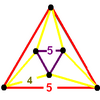
|

|
| 30 | bitruncated order-5 dodecahedral (diddoh) t1,2{5,3,5} |
(2) (5.6.6) |
(2) (5.6.6) |

|

| ||
| 31 | cantitruncated order-5 dodecahedral (gripped) t0,1,2{5,3,5} |
(1) (5.6.6) |
(1) (4.4.5) |
(2) (4.6.10) |

|

| |
| 32 | runcitruncated order-5 dodecahedral (pripped) t0,1,3{5,3,5} |
(1) (3.5.4.5) |
(1) (4.4.5) |
(2) (4.4.10) |
(1) (3.10.10) |

|

|
| 33 | omnitruncated order-5 dodecahedral (gipidded) t0,1,2,3{5,3,5} |
(1) (4.6.10) |
(1) (4.4.10) |
(1) (4.4.10) |
(1) (4.6.10) |
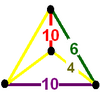
|

|
| # | Name of honeycomb Coxeter diagram |
Cells by location and count per vertex | Vertex figure | Picture | ||||
|---|---|---|---|---|---|---|---|---|
| 0 |
1 |
2 |
3 |
Alt | ||||
| Nonuniform | omnisnub order-5 dodecahedral ht0,1,2,3{5,3,5} |
(1) (3.3.3.3.5) |
(1) (3.3.3.5) |
(1) (3.3.3.5) |
(1) (3.3.3.3.5) |
(4) +(3.3.3) |

|
|
[5,31,1] family
There are 11 forms (and only 4 not shared with [5,3,4] family), generated by ring permutations of the Coxeter group: [5,31,1] or ![]()
![]()
![]()
![]()
![]() . If the branch ring states match, an extended symmetry can double into the [5,3,4] family,
. If the branch ring states match, an extended symmetry can double into the [5,3,4] family, ![]()
![]()
![]()
![]()
![]() ↔
↔ ![]()
![]()
![]()
![]()
![]()
![]()
![]() .
.
| # | Honeycomb name Coxeter diagram |
Cells by location (and count around each vertex) |
vertex figure | Picture | |||
|---|---|---|---|---|---|---|---|
| 0 |
1 |
0' |
3 | ||||
| 34 | alternated order-5 cubic (apech) |
- | - | (12) (3.3.3.3.3) |
(20) (3.3.3) |

|

|
| 35 | cantic order-5 cubic (tapech) |
(1) (3.5.3.5) |
- | (2) (5.6.6) |
(2) (3.6.6) |

|

|
| 36 | runcic order-5 cubic (birapech) |
(1) (5.5.5) |
- | (3) (3.4.5.4) |
(1) (3.3.3) |

|

|
| 37 | runcicantic order-5 cubic (bitapech) |
(1) (3.10.10) |
- | (2) (4.6.10) |
(1) (3.6.6) |

|

|
| # | Honeycomb name Coxeter diagram |
Cells by location (and count around each vertex) |
vertex figure | Picture | |||
|---|---|---|---|---|---|---|---|
| 0 |
1 |
3 |
Alt | ||||
| [10] | Order-4 dodecahedral (doehon) |
(4) (5.5.5) |
- | - | 
|

| |
| [11] | rectified order-4 dodecahedral (riddoh) |
(2) (3.5.3.5) |
- | (2) (3.3.3.3) |

|

| |
| [12] | rectified order-5 cubic (ripech) |
(1) (3.3.3.3.3) |
- | (5) (3.4.3.4) |

|

| |
| [15] | bitruncated order-5 cubic (ciddoh) |
(1) (5.6.6) |
- | (2) (4.6.6) |

|

| |
| [14] | truncated order-4 dodecahedral (tiddoh) |
(2) (3.10.10) |
- | (1) (3.3.3.3) |

|

| |
| [17] | cantellated order-4 dodecahedral (sriddoh) |
(1) (3.4.5.4) |
(2) (4.4.4) |
(1) (3.4.3.4) |

|

| |
| [20] | cantitruncated order-4 dodecahedral (griddoh) |
(1) (4.6.10) |
(1) (4.4.4) |
(1) (4.6.6) |

|

| |
| Nonuniform | snub rectified order-4 dodecahedral |
(2) (3.3.3.3.5) |
(1) (3.3.3) |
(2) (3.3.3.3.3) |
(4) +(3.3.3) |
 Irr. tridiminished icosahedron | |
[(4,3,3,3)] family
There are 9 forms, generated by ring permutations of the Coxeter group: ![]()
![]()
![]()
![]()
The bitruncated and runcinated forms (41 and 42) contain the faces of two regular skew polyhedrons: {8,6|3} and {6,8|3}.
| # | Honeycomb name Coxeter diagram |
Cells by location (and count around each vertex) |
vertex figure | Picture | ||||
|---|---|---|---|---|---|---|---|---|
| 0 |
1 |
2 |
3 |
Alt | ||||
| 38 | tetrahedral-cubic (gadtatdic) {(3,3,3,4)} |
(4) (3.3.3) |
- | (4) (4.4.4) |
(6) (3.4.3.4) |

|

| |
| 39 | tetrahedral-octahedral (gacocaddit) {(3,3,4,3)} |
(12) (3.3.3.3) |
(8) (3.3.3) |
- | (8) (3.3.3.3) |

|

| |
| 40 | cyclotruncated tetrahedral-cubic (cytitch) ct{(3,3,3,4)} |
(3) (3.6.6) |
(1) (3.3.3) |
(1) (4.4.4) |
(3) (4.6.6) |

|

| |
| 41 | cyclotruncated cube-tetrahedron (cyticth) ct{(4,3,3,3)} |
(1) (3.3.3) |
(1) (3.3.3) |
(3) (3.8.8) |
(3) (3.8.8) |

|

| |
| 42 | cyclotruncated octahedral-tetrahedral (cytoth) ct{(3,3,4,3)} |
(4) (3.6.6) |
(4) (3.6.6) |
(1) (3.3.3.3) |
(1) (3.3.3.3) |

|

| |
| 43 | rectified tetrahedral-cubic (ritch) r{(3,3,3,4)} |
(1) (3.3.3.3) |
(2) (3.4.3.4) |
(1) (3.4.3.4) |
(2) (3.4.4.4) |

|

| |
| 44 | truncated tetrahedral-cubic (titch) t{(3,3,3,4)} |
(1) (3.6.6) |
(1) (3.4.3.4) |
(1) (3.8.8) |
(2) (4.6.8) |

|

| |
| 45 | truncated tetrahedral-octahedral (titdoh) t{(3,3,4,3)} |
(2) (4.6.6) |
(1) (3.6.6) |
(1) (3.4.4.4) |
(1) (4.6.6) |

|

| |
| 46 | omnitruncated tetrahedral-cubic (otitch) tr{(3,3,3,4)} |
(1) (4.6.6) |
(1) (4.6.6) |
(1) (4.6.8) |
(1) (4.6.8) |

|

| |
| Nonuniform | omnisnub tetrahedral-cubic sr{(3,3,3,4)} |
(1) (3.3.3.3.3) |
(1) (3.3.3.3.3) |
(1) (3.3.3.3.4) |
(1) (3.3.3.3.4) |
(4) +(3.3.3) |

| |
[(5,3,3,3)] family
There are 9 forms, generated by ring permutations of the Coxeter group: ![]()
![]()
![]()
![]()
The bitruncated and runcinated forms (50 and 51) contain the faces of two regular skew polyhedrons: {10,6|3} and {6,10|3}.
| # | Honeycomb name Coxeter diagram |
Cells by location (and count around each vertex) |
vertex figure | Picture | |||
|---|---|---|---|---|---|---|---|
| 0 |
1 |
2 |
3 | ||||
| 47 | tetrahedral-dodecahedral |
(4) (3.3.3) |
- | (4) (5.5.5) |
(6) (3.5.3.5) |

|

|
| 48 | tetrahedral-icosahedral |
(30) (3.3.3.3) |
(20) (3.3.3) |
- | (12) (3.3.3.3.3) |

|

|
| 49 | cyclotruncated tetrahedral-dodecahedral |
(3) (3.6.6) |
(1) (3.3.3) |
(1) (5.5.5) |
(3) (5.6.6) |

|

|
| 52 | rectified tetrahedral-dodecahedral |
(1) (3.3.3.3) |
(2) (3.4.3.4) |
(1) (3.5.3.5) |
(2) (3.4.5.4) |

|

|
| 53 | truncated tetrahedral-dodecahedral |
(1) (3.6.6) |
(1) (3.4.3.4) |
(1) (3.10.10) |
(2) (4.6.10) |

|

|
| 54 | truncated tetrahedral-icosahedral |
(2) (4.6.6) |
(1) (3.6.6) |
(1) (3.4.5.4) |
(1) (5.6.6) |

|

|
| # | Honeycomb name Coxeter diagram |
Cells by location (and count around each vertex) |
vertex figure | Picture | ||
|---|---|---|---|---|---|---|
| 0,1 |
2,3 |
Alt | ||||
| 50 | cyclotruncated dodecahedral-tetrahedral |
(2) (3.3.3) |
(6) (3.10.10) |

|

| |
| 51 | cyclotruncated tetrahedral-icosahedral |
(10) (3.6.6) |
(2) (3.3.3.3.3) |

|

| |
| 55 | omnitruncated tetrahedral-dodecahedral |
(2) (4.6.6) |
(2) (4.6.10) |

|

| |
| Nonuniform | omnisnub tetrahedral-dodecahedral |
(2) (3.3.3.3.3) |
(2) (3.3.3.3.5) |
(4) +(3.3.3) |

| |
[(4,3,4,3)] family
There are 6 forms, generated by ring permutations of the Coxeter group: ![]()
![]()
![]()
![]()
![]() . There are 4 extended symmetries possible based on the symmetry of the rings:
. There are 4 extended symmetries possible based on the symmetry of the rings: ![]()
![]()
![]()
![]()
![]() ,
, ![]()
![]()
![]()
![]()
![]() ,
, ![]()
![]()
![]()
![]()
![]() , and
, and ![]()
![]()
![]()
![]()
![]() .
.
This symmetry family is also related to a radical subgroup, index 6, ![]()
![]()
![]()
![]() ↔
↔ ![]()
![]()
![]()
![]()
![]()
![]()
![]() , constructed by [(4,3,4,3*)], and represents a trigonal trapezohedron fundamental domain.
, constructed by [(4,3,4,3*)], and represents a trigonal trapezohedron fundamental domain.
The truncated forms (57 and 58) contain the faces of two regular skew polyhedrons: {6,6|4} and {8,8|3}.
| # | Honeycomb name Coxeter diagram |
Cells by location (and count around each vertex) |
vertex figure | Pictures | |||
|---|---|---|---|---|---|---|---|
| 0 |
1 |
2 |
3 | ||||
| 56 | cubic-octahedral (cohon) |
(6) (3.3.3.3) |
- | (8) (4.4.4) |
(12) (3.4.3.4) |

|

|
| 60 | truncated cubic-octahedral (tucoh) |
(1) (4.6.6) |
(1) (3.4.4.4) |
(1) (3.8.8) |
(2) (4.6.8) |

|

|
| # | Honeycomb name Coxeter diagram |
Cells by location (and count around each vertex) |
vertex figure | Picture | ||
|---|---|---|---|---|---|---|
| 0,3 |
1,2 |
Alt | ||||
| 57 | cyclotruncated octahedral-cubic (cytoch) |
(6) (4.6.6) |
(2) (4.4.4) |

|

| |
| Nonuniform | cyclosnub octahedral-cubic |
(4) (3.3.3.3.3) |
(2) (3.3.3) |
(4) +(3.3.3.3) |

|
|
| # | Honeycomb name Coxeter diagram |
Cells by location (and count around each vertex) |
vertex figure | Picture | |
|---|---|---|---|---|---|
| 0,1 |
2,3 | ||||
| 58 | cyclotruncated cubic-octahedral (cytacoh) |
(2) (3.3.3.3) |
(6) (3.8.8) |

|

|
| # | Honeycomb name Coxeter diagram |
Cells by location (and count around each vertex) |
vertex figure | Picture | |
|---|---|---|---|---|---|
| 0,2 |
1,3 | ||||
| 59 | rectified cubic-octahedral (racoh) |
(2) (3.4.3.4) |
(4) (3.4.4.4) |

|

|
| # | Honeycomb name Coxeter diagram |
Cells by location (and count around each vertex) |
vertex figure | Picture | |
|---|---|---|---|---|---|
| 0,1,2,3 |
Alt | ||||
| 61 | omnitruncated cubic-octahedral (otacoh) |
(4) (4.6.8) |

|

| |
| Nonuniform | omnisnub cubic-octahedral |
(4) (3.3.3.3.4) |
(4) +(3.3.3) |

|
|
[(4,3,5,3)] family
There are 9 forms, generated by ring permutations of the Coxeter group: ![]()
![]()
![]()
![]()
![]()
The truncated forms (65 and 66) contain the faces of two regular skew polyhedrons: {10,6|3} and {6,10|3}.
| # | Honeycomb name Coxeter diagram |
Cells by location (and count around each vertex) |
vertex figure | Picture | |||
|---|---|---|---|---|---|---|---|
| 0 |
1 |
2 |
3 | ||||
| 62 | octahedral-dodecahedral |
(6) (3.3.3.3) |
- | (8) (5.5.5) |
(1) (3.5.3.5) |
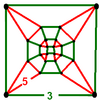
|

|
| 63 | cubic-icosahedral |
(30) (3.4.3.4) |
(20) (4.4.4) |
- | (12) (3.3.3.3.3) |

|

|
| 64 | cyclotruncated octahedral-dodecahedral |
(3) (4.6.6) |
(1) (4.4.4) |
(1) (5.5.5) |
(3) (5.6.6) |

|

|
| 67 | rectified octahedral-dodecahedral |
(1) (3.4.3.4) |
(2) (3.4.4.4) |
(1) (3.5.3.5) |
(2) (3.4.5.4) |

|

|
| 68 | truncated octahedral-dodecahedral |
(1) (4.6.6) |
(1) (3.4.4.4) |
(1) (3.10.10) |
(2) (4.6.10) |

|

|
| 69 | truncated cubic-dodecahedral |
(2) (4.6.8) |
(1) (3.8.8) |
(1) (3.4.5.4) |
(1) (5.6.6) |

|

|
| # | Honeycomb name Coxeter diagram |
Cells by location (and count around each vertex) |
vertex figure | Picture | ||
|---|---|---|---|---|---|---|
| 0,1 |
2,3 |
Alt | ||||
| 65 | cyclotruncated dodecahedral-octahedral |
(2) (3.3.3.3) |
(8) (3.10.10) |

|

| |
| 66 | cyclotruncated cubic-icosahedral |
(10) (3.8.8) |
(2) (3.3.3.3.3) |

|

| |
| 70 | omnitruncated octahedral-dodecahedral |
(2) (4.6.8) |
(2) (4.6.10) |

|

| |
| Nonuniform | omnisnub octahedral-dodecahedral |
(2) (3.3.3.3.4) |
(2) (3.3.3.3.5) |
(4) +(3.3.3) |

| |
[(5,3,5,3)] family
There are 6 forms, generated by ring permutations of the Coxeter group: ![]()
![]()
![]()
![]()
![]() . There are 4 extended symmetries possible based on the symmetry of the rings:
. There are 4 extended symmetries possible based on the symmetry of the rings: ![]()
![]()
![]()
![]()
![]() ,
, ![]()
![]()
![]()
![]()
![]() ,
, ![]()
![]()
![]()
![]()
![]() , and
, and ![]()
![]()
![]()
![]()
![]() .
.
The truncated forms (72 and 73) contain the faces of two regular skew polyhedrons: {6,6|5} and {10,10|3}.
| # | Honeycomb name Coxeter diagram |
Cells by location (and count around each vertex) |
vertex figure | Picture | ||||
|---|---|---|---|---|---|---|---|---|
| 0 |
1 |
2 |
3 |
Alt | ||||
| 71 | dodecahedral-icosahedral |
(12) (3.3.3.3.3) |
- | (20) (5.5.5) |
(30) (3.5.3.5) |

|

| |
| 72 | cyclotruncated icosahedral-dodecahedral |
(3) (5.6.6) |
(1) (5.5.5) |
(1) (5.5.5) |
(3) (5.6.6) |

|

| |
| 73 | cyclotruncated dodecahedral-icosahedral |
(1) (3.3.3.3.3) |
(1) (3.3.3.3.3) |
(3) (3.10.10) |
(3) (3.10.10) |

|

| |
| 74 | rectified dodecahedral-icosahedral |
(1) (3.5.3.5) |
(2) (3.4.5.4) |
(1) (3.5.3.5) |
(2) (3.4.5.4) |

|

| |
| 75 | truncated dodecahedral-icosahedral |
(1) (5.6.6) |
(1) (3.4.5.4) |
(1) (3.10.10) |
(2) (4.6.10) |

|

| |
| 76 | omnitruncated dodecahedral-icosahedral |
(1) (4.6.10) |
(1) (4.6.10) |
(1) (4.6.10) |
(1) (4.6.10) |

|

| |
| Nonuniform | omnisnub dodecahedral-icosahedral |
(1) (3.3.3.3.5) |
(1) (3.3.3.3.5) |
(1) (3.3.3.3.5) |
(1) (3.3.3.3.5) |
(4) +(3.3.3) |

| |
Other non-Wythoffians
There are several other known non-Wythoffian uniform compact hyperbolic honeycombs, and it is not known how many are left to be discovered. Two have been listed above as diminishings of the icosahedral honeycomb {3,5,3}.[6]
In 1997 Wendy Krieger discovered an infinite series of uniform hyperbolic honeycombs with pseudoicosahedral vertex figures, made from 8 cubes and 12 p-gonal prisms at a vertex for any integer p. In the case p = 4, all cells are cubes and the result is the order-5 cubic honeycomb.[6]
Another two known ones are related to noncompact families. The tessellation ![]()
![]()
![]()
![]()
![]()
![]()
![]() consists of truncated cubes
consists of truncated cubes ![]()
![]()
![]()
![]()
![]() and infinite order-8 triangular tilings
and infinite order-8 triangular tilings ![]()
![]()
![]()
![]()
![]() . However the latter intersect the sphere at infinity orthogonally, having exactly the same curvature as the hyperbolic space, and can be replaced by mirror images of the remainder of the tessellation, resulting in a compact uniform honeycomb consisting only of the truncated cubes. (So they are analogous to the hemi-faces of spherical hemipolyhedra.)[6][7] Something similar can be done with the tessellation
. However the latter intersect the sphere at infinity orthogonally, having exactly the same curvature as the hyperbolic space, and can be replaced by mirror images of the remainder of the tessellation, resulting in a compact uniform honeycomb consisting only of the truncated cubes. (So they are analogous to the hemi-faces of spherical hemipolyhedra.)[6][7] Something similar can be done with the tessellation ![]()
![]()
![]()
![]()
![]() consisting of small rhombicuboctahedra
consisting of small rhombicuboctahedra ![]()
![]()
![]()
![]()
![]() , infinite order-8 triangular tilings
, infinite order-8 triangular tilings ![]()
![]()
![]()
![]()
![]() , and infinite order-8 square tilings
, and infinite order-8 square tilings ![]()
![]()
![]()
![]()
![]() . The order-8 square tilings already intersect the sphere at infinity orthogonally, and if the order-8 triangular tilings are augmented with a set of triangular prisms, the surface passing through their centre points also intersects the sphere at infinity orthogonally. After replacing with mirror images, the result is a compact honeycomb containing the small rhombicuboctahedra and the triangular prisms.[8]
. The order-8 square tilings already intersect the sphere at infinity orthogonally, and if the order-8 triangular tilings are augmented with a set of triangular prisms, the surface passing through their centre points also intersects the sphere at infinity orthogonally. After replacing with mirror images, the result is a compact honeycomb containing the small rhombicuboctahedra and the triangular prisms.[8]
Another non-Wythoffian was discovered in 2021. It has as vertex figure a snub cube with 8 vertices removed and contains two octahedra and eight snub cubes at each vertex.[6] Subsequently Krieger found a non-Wythoffian with a snub cube as the vertex figure, containing 32 tetrahedra and 6 octahedra at each vertex, and that the truncated and rectified versions of this honeycomb are still uniform. In 2022, Richard Klitzing generalised this construction to use any snub ![]()
![]()
![]()
![]()
![]() as vertex figure: the result is compact for p=4 or 5 (with a snub cube or snub dodecahedral vertex figure respectively), paracompact for p=6 (with a snub trihexagonal tiling as the vertex figure), and hypercompact for p>6. Again, the truncated and rectified versions of these honeycombs are still uniform.[6]
as vertex figure: the result is compact for p=4 or 5 (with a snub cube or snub dodecahedral vertex figure respectively), paracompact for p=6 (with a snub trihexagonal tiling as the vertex figure), and hypercompact for p>6. Again, the truncated and rectified versions of these honeycombs are still uniform.[6]
Summary enumeration of compact uniform honeycombs
This is the complete enumeration of the 76 Wythoffian uniform honeycombs. The alternations are listed for completeness, but most are non-uniform.
| Index | Coxeter group | Extended symmetry |
Honeycombs | Chiral extended symmetry |
Alternation honeycombs | ||
|---|---|---|---|---|---|---|---|
| H1 | [4,3,5] |
[4,3,5] |
15 | [1+,4,(3,5)+] | (2) | ||
| [4,3,5]+ | (1) | ||||||
| H2 | [3,5,3] |
[3,5,3] |
6 | ||||
| [2+[3,5,3]] |
5 | [2+[3,5,3]]+ | (1) | ||||
| H3 | [5,31,1] |
[5,31,1] |
4 | ||||
| [1[5,31,1]]=[5,3,4] |
(7) | [1[5,31,1]]+ =[5,3,4]+ |
(1) | ||||
| H4 | [(4,3,3,3)] |
[(4,3,3,3)] | 6 | ||||
| [2+[(4,3,3,3)]] |
3 | [2+[(4,3,3,3)]]+ | (1) | ||||
| H5 | [5,3,5] |
[5,3,5] |
6 | ||||
| [2+[5,3,5]] |
3 | [2+[5,3,5]]+ | (1) | ||||
| H6 | [(5,3,3,3)] |
[(5,3,3,3)] | 6 | ||||
| [2+[(5,3,3,3)]] |
3 | [2+[(5,3,3,3)]]+ | (1) | ||||
| H7 | [(3,4)[2]] |
[(3,4)[2]] | 2 | ||||
| [2+[(3,4)[2]]] |
1 | ||||||
| [2+[(3,4)[2]]] |
1 | ||||||
| [2+[(3,4)[2]]] |
1 | [2+[(3+,4)[2]]] | (1) | ||||
| [(2,2)+[(3,4)[2]]] |
1 | [(2,2)+[(3,4)[2]]]+ | (1) | ||||
| H8 | [(5,3,4,3)] |
[(5,3,4,3)] | 6 | ||||
| [2+[(5,3,4,3)]] |
3 | [2+[(5,3,4,3)]]+ | (1) | ||||
| H9 | [(3,5)[2]] |
[(3,5)[2]] | 2 | ||||
| [2+[(3,5)[2]]] |
1 | ||||||
| [2+[(3,5)[2]]] |
1 | ||||||
| [2+[(3,5)[2]]] |
1 | ||||||
| [(2,2)+[(3,5)[2]]] |
1 | [(2,2)+[(3,5)[2]]]+ | (1) | ||||
See also
Notes
- ^ Humphreys, 1990, page 141, 6.9 List of hyperbolic Coxeter groups, figure 2 [1]
- ^ a b Felikson, 2002
- ^ Wendy Y. Krieger, Walls and bridges: The view from six dimensions, Symmetry: Culture and Science Volume 16, Number 2, pages 171–192 (2005) [2]
- ^ a b "Spd{3,5,3".}
- ^ "Pd{3,5,3".}
- ^ a b c d e "Hyperbolic Tesselations".
- ^ "x4x3o8o".
- ^ "lt-o8o4xb3x".
References
- J. Humphreys (1990), Reflection Groups and Coxeter Groups, Cambridge studies in advanced mathematics, 29
- H.S.M. Coxeter (1954), "Regular Honeycombs in Hyperbolic Space" Proceedings of the International Congress of Mathematicians, vol. 3, North-Holland, pp. 155–169. Reprinted as Ch. 10 in Coxeter (1999), The Beauty of Geometry: Twelve Essays, Dover, ISBN 0-486-40919-8
- H.S.M. Coxeter (1973), Regular Polytopes, 3rd. ed., Dover Publications, 1973. ISBN 0-486-61480-8. (Tables I and II: Regular polytopes and honeycombs, pp. 294–296)
- J. Weeks The Shape of Space, 2nd ed. ISBN 0-8247-0709-5, Chapters 16–17: Geometries on Three-manifolds I, II
- A. Felikson (2002), "Coxeter Decompositions of Hyperbolic Tetrahedra" (preprint) arXiv:math/0212010
- C. W. L. Garner, Regular Skew Polyhedra in Hyperbolic Three-Space Can. J. Math. 19, 1179–1186, 1967. PDF [3] Archived 2015-04-02 at the Wayback Machine
- N. W. Johnson (2018), Geometries and Transformations, Chapters 11–13
- N. W. Johnson, R. Kellerhals, J. G. Ratcliffe, S. T. Tschantz (1999), The size of a hyperbolic Coxeter simplex, Transformation Groups, Volume 4, Issue 4, pp 329–353 [4]
- N. W. Johnson, R. Kellerhals, J.G. Ratcliffe, S.T. Tschantz, Commensurability classes of hyperbolic Coxeter groups H3: p130. [5]
- Klitzing, Richard. "Hyperbolic honeycombs H3 compact".
















